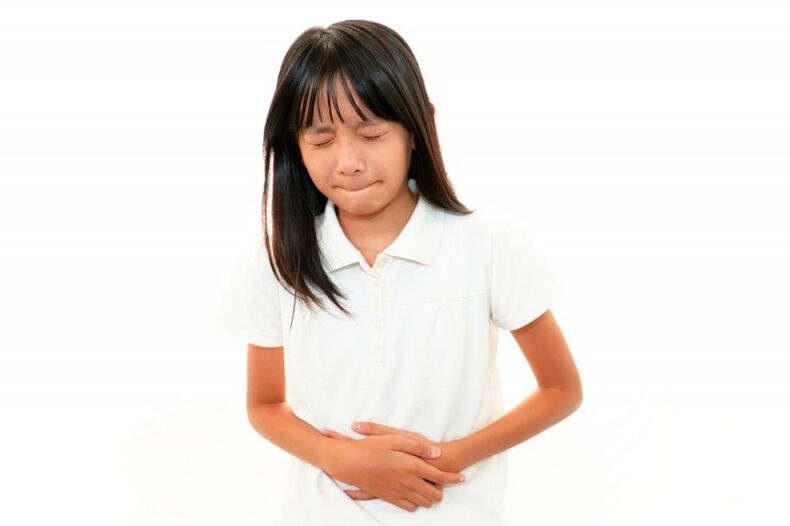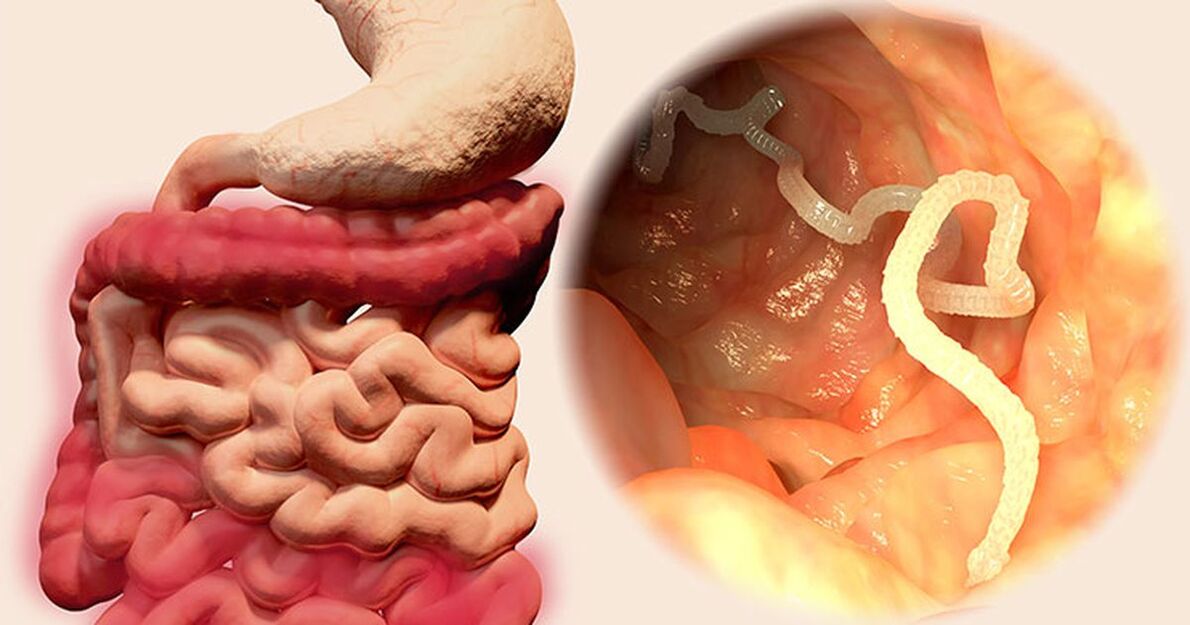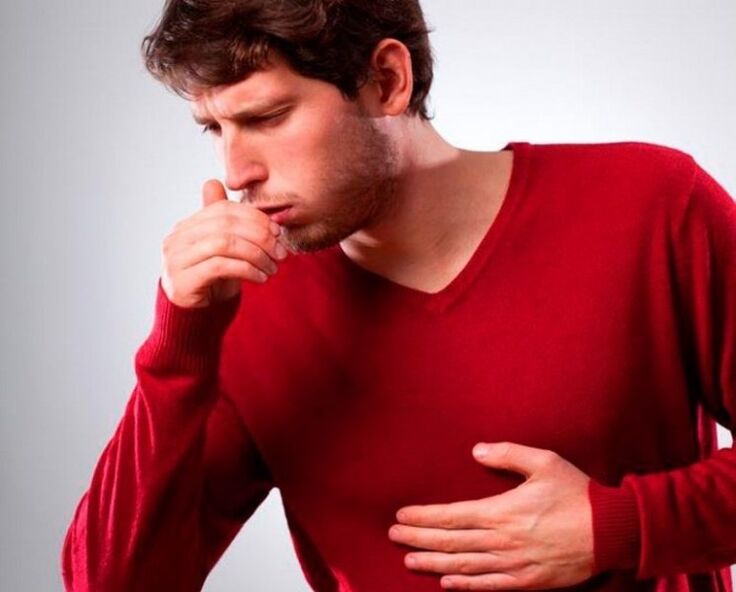
Human parasites inhabit any of its organs and systems. These creatures enter the human body from the environment, and are carried throughout the body with the bloodstream. There are a large number of parasites that can live in the human body. All of these pose a threat to human health and lead to negative changes in organ work.
Human parasites. The signs of worms appearing on humans are obvious and hidden. The obvious ones include "unreasonable" weight loss, pale complexion (skin anemia), chronic fatigue, and night anal itching. These manifestations are well known and are indicators of contamination.
How can you get a worm
Human parasites. To protect yourself, you need to know 4 ways to spread and infect eggs with eggs:
- Through soil and water-ground worm disease. They develop in sand, soil and water, then enter the human body and begin to lay eggs there. In addition, the worm's eggs and excrement enter the external environment, waiting in the wings to infect new people. Eating unwashed vegetables and fruits, dirty hands, and dust on food can cause human infection with worms. Some parasite eggs enter the human body through the skin of the feet and ankles.
- Through direct contact. Worms in pets and humans are spread through hand contact, games, and joint activities.
- Through the use of contaminated animal-derived food-biological helminthiasis. Eating raw and poorly processed meat (kebab, bacon, preserves, homemade game) and fish (sushi, dried fish, preserved fish) is potentially dangerous. There is a possibility of intestinal infection and biological worms.
- There are insect bites. This type of infection is very rare. These include myiasis, Cantalia disease and polio. Don't confuse parasite eggs with insect larvae, they are also deposited under the skin of animals and humans (for example, gadfly larvae).
The main mechanism of worm propagation
- Soil, sand and other types of soil are the most fertile habitat for worm eggs. As a result, the plants are in constant contact with the ground. When harvesting, vegetables, fruits and vegetables touch the hands of workers, the dusty shelves and trucks of vegetable shops. In this case, the food is likely to be contaminated with parasite eggs. Therefore, the plant-derived products must be thoroughly washed under running water, and then poured in boiling water. Be especially vigilant in the country. Pets walk around in the yard and then enter the house. It is not difficult to imagine what kind of sewage cats and dogs would pour into the house after walking at night. Flies and cockroaches are also carriers of worm eggs. When sitting on food, insects can infect your food. Any contact with soil and sand can cause parasites to enter the human body. Therefore, it is necessary to wash hands thoroughly, especially under nails. This applies especially to children.
- From person to person. This infection mechanism is very effective. For example, pinworms lay eggs around the anus at night. A sleeping child will scratch the place where the eggs are laid because it starts to itch. Thousands of eggs fell on clothes, beds, door handles in the morning, and even before washing hands and face in the morning, little irritable things would fall off. Therefore, the entire family is at risk of being infected.
- Through contact with water. The open body of water contains a large number of types of worms. Bathing and accidentally swallowing water are serious risks of infection

Children are more susceptible to worms than adults. This is because the child's body is not well protected (the defense mechanism has just been formed), and the child takes the initiative to contact the external environment. It takes incredible effort for parents to teach him the basic rules of personal hygiene.
Babies under 6 years of age are at high risk of infection. According to statistics, about 95% of children under the age of 4-5 are infected with worms. Therefore, special attention must be paid to prevention.
Most types of worms are in the body and only lay their eggs there and die after a period of time. For example, the lifespan of pinworms is 6-8 weeks, and the lifespan of roundworms is as long as 1 year. The number of internal parasites only increases as new eggs enter from the outside.
The treatment allows you to get rid of the worms faster and stop laying eggs in the intestines. It is almost impossible for a child with helminthiasis to recover without medicine. New eggs will continue to enter the mouth, replenishing the ranks of adults in the child.
Identify the signs of worm invasion
It is not uncommon for worms to invade, in which visceral diseases are aggravated, and diseases that have not been shown before appear. These are considered hidden signs. A person is brought to the treatment of many diseases, but the cause is not cared about. At the same time, treatment will not bring results. The following are examples of such cases:
Infectious diseases caused by weakened immunity
Parasites exist in the human body, consume a variety of nutrients and release toxic substances. This situation will significantly reduce the patient's immunity. The deterioration of chronic diseases may start various inflammatory processes in the nasopharynx. There is no point in treating sinusitis or stomatitis in a standard way. It is important to rule out the cause.
In girls and women, inflammation of the uterine appendages, vulvovaginitis, and vaginosis of various origins can often begin.
General discomfort caused by body poisoning

The more severe the worm invasion of the patient, the more harmful substances the parasite releases. This has adverse effects on the health and nervous system of adults and children. An example of this is migraine, dizziness, and joint pain. To overcome the nausea, the person took painkillers, but the pain returned shortly afterwards: the cause of the illness was ignored.
In children, neurological diseases are accompanied by irritability, apathy, and aggression.
If your child starts to sleep poorly, dream, have nightmares, or sneak into school, then it's time to start preventing worms.
Allergic reactions, skin diseases
Human parasites. Worm waste is believed to be the cause of allergens. Skin reactions (rash, itching, rash, peeling skin) are the fewest symptoms that can occur at the beginning of an allergy. General reactions of the body may occur: asthma, rhinitis, and cough worsening. Sometimes worm invasion is accompanied by fragility and hair loss, cracked heel skin and peeling nails.
Gastrointestinal disease
Depending on the severity of the infection, symptoms can range from mild to severe forms of the disease. From mild nausea and diarrhea, to chronic flatulence, constipation, vomiting, belly button and hypochondriac pain. Worms in the tissues do not affect the gastrointestinal tract like intestinal parasites.
In which organs can parasites live?
Human parasites are divided into two categories, which correspond to the active parts of the donor's body.
- Cavities-worms that live in different parts of the gastrointestinal tract. There are about 100 species of intestinal parasites, and there are dozens of species in each part of the intestinal tract. The small intestine is ready to receive roundworms, antistoma nematodes, tapeworms and other less common "brothers". The small intestine will "share living space" with pinworms and tapeworms. The medical literature describes the situation where a person is infected with multiple parasites at the same time.
- Tissues-worms located in organs, tissues and even blood. Modern medicine has successfully dealt with paragonimiasis (lung), cysticercosis (brain), hydatid disease (liver) and filariasis (lymphatic vessels). Some worm larvae pass through the body through the circulatory system and randomly attach to any organ. If many eggs are introduced, the entire body may be infected.
Symptoms of worms depend on the type of parasite
Different types of worms in humans have different symptoms. It is also worth considering the duration and intensity of the parasite infection and the general condition of the patient before the infection. The following table summarizes the main symptoms of worms in humans according to the types of worms.
| Parasite type (disease) | Method of infection | symptom | Time of symptom onset |
| Pinworm disease (pinworm disease) | Foods with plant sources. | Itching at night around the anus, the presence of parasites in the stool, and short-term severe pain in the belly button. | 2-3 days after infection |
| Vlasoglav (trichosis) | Prepare contaminated food under unsanitary conditions. | Symptoms are only manifested in severe attacks: diarrhea, abdominal pain, loss of appetite, and inflammation of the appendix. In children, physical development may be delayed, and rectal prolapse may even occur. | few weeks |
| Widespread tapeworm (diphyllial filariasis) | When eating infected river fish. | This parasite can live in patients for up to 25 years. Intestinal mechanical damage, vitamin deficiency, intestinal obstruction, body poisoning, allergies. | few weeks |
| Roundworm (hookworm) | When walking barefoot on live soil. | Where the parasite enters, the feet and legs are itchy and swollen. Cough, excessive sputum, bronchial and lung damage. Weakness and dizziness. Women's menstrual cycles are disturbed. Men have impotence. | Few days |
| Ascaris (Ascarissis) | Foods with plant sources. | Intestinal pain, peritonitis, bronchitis, pneumonia, liver disease, pancreas. Climbing from the gastrointestinal tract into the esophagus or respiratory tract may cause suffocation. | About 3 months |
| Trichinella (Trichinellasis) | Poorly processed meat, lard. | Nausea and heartburn, diarrhea. | 2 days |
| Liver flukes and giant flukes (fasciasis) | Grow food and water. | Fever, dry cough, loss of appetite, abdominal pain. | 2-4 weeks |
The symptoms of helminthiasis are as diverse as the pathogens of parasitic diseases, and their life cycles, entry pathways, migration, and favorite positioning are different from each other.
The general symptoms of parasitic diseases can be explained by the following facts: with the invasion of worms, the parasites will suppress the person's own immunity and promote the development of inflammation and autoimmune processes. General symptoms are related to poisoning, parasite death, parasite life activities and reproduction, manifested as weakness, instability and emotional changes, academic performance and performance, memory and children's learning ability decline.

The appearance of hypochondriac pain, bitterness, and jaundice on the right side may indicate that the parasitic disease is mainly located in the hepatoduodenal area (liver and duct area). At the same time, the patient may notice episodes of nausea and reflux (vomiting).
For example, when infected with flatworms-opisthorchis, human parasites associated with damage to the liver and ducts belonging to the hepatobiliary system have been observed. When eating certain species of poorly processed fish (carp), this worm enters the body of the ultimate owner-a person.
Symptoms related to liver and duct damage related to the hepatobiliary system are observed, for example, when infected with flatworms-opisthorchis.
The disease is endemic and has a special distribution area. For the spread of pathogens, the larvae of the parasite must go through a complex cycle that changes with the host (a certain mollusk, carp).
Human parasites. Usually, along with many parasitic diseases, certain skin manifestations of skin diseases such as skin itching, various rashes, scratching, atopic dermatitis, eczema, etc. appear. Skin protrusions are not always related to worm invasion, and treatment by dermatologists is not successful.
Importantly, helminthiasis can affect any organ and tissue. Patients often worry about headaches, joint pain (joint syndrome), and upper and lower respiratory tract discomfort. In general, persistent coughing, frequent SARS, pharyngitis, laryngitis, and dyspnea are all related to inflammation, and a key part of its pathogenesis is parasite (helminth) infection.
Giardiasis and its characteristics
Giardiasis is a protozoan disease in which the pathogen exists in both vegetative and encapsulated forms. Giardia infection occurs when cysts are swallowed. The cysts are very persistent in the environment and can last a long time in the environment (soil, food, water, various objects).
One milliliter of feces may contain millions of Lang's cysts, and when placed in a favorable environment, they can be transformed into a vegetative form. In the human intestine, the cyst forms a nutritious and mobile form within a few hours. The flagella is attached between the intestinal epithelial cells, where the pathogen finds a suitable environment for itself, with sufficient carbohydrates. Food, this is the favorite substrate for Lambria.
Giardia is divided into binary (in two parts) in a favorable environment, and their number will increase many times soon. In addition to the intestines, the nutritional form of Lamblia affects the hepatobiliary system (biliary ducts, gallbladder).
Symptoms of giardiasis are related to signs of weakness, poor academic performance, weakness, and intestinal and hepatobiliary tract damage. The course of giardiasis and other parasitic diseases is largely related to the characteristics of the immune response. Intestinal form, gastrointestinal colitis-a common form of Giardiasis. The endotoxin of the pathogen affects the nervous system, which explains the existence of many common extraintestinal symptoms.
Ascariasis
Another common and ubiquitous parasitic disease is ascariasis. This helminthiasis is more common in children, but in adult patients, it usually causes a lot of discomfort and symptoms. Many chronic inflammatory diseases and somatic pathologies can be triggered by the invasion of parasites and are exacerbated by the presence of various parasites (including roundworms).
Usually, children and adults of roundworm carriers will develop chronic colitis, enteritis, bronchitis, and may even develop serious diseases such as bronchial asthma. Other allergic processes (atopic dermatitis, eczema, rhinitis, psoriasis) may also developGet support.
Human parasites. Roundworms enter the stomach when they swallow eggs. After the larva enters the upper part of the digestive tract (stomach), it is freed from the sac, migrates into the blood vessel, and enters the alveoli of the lung system with the blood flow, causing the patient to cough, cough and other phenomena of bronchitis.

Usually this condition is considered to be a viral infection, worsening of chronic bronchopulmonary disease, in this case, it is usually related to the movement of parasite larvae.
Ascaris larvae cough up, the pathogen with sputum enters the pharynx, swallows with saliva, re-enters the stomach, and then enters the intestine, providing favorable conditions for the further growth and development of roundworms.
In the human intestine, roundworms feed on their contents and become sexually mature individuals (50 cm for females and 20 cm for males). In the process of growth and life activities, and due to the migration of larvae, parasites have negative toxicity and mechanical effects on the human body.
In the process of growth, life activity, egg laying and maturation, pathogenic bacteria have an inhibitory effect on the body's immunity and can cause diseases and anemia in the digestive tract such as the lungs and intestines. Roundworms can live in the human intestine for up to a year.
Anthelmintics
With the help of a large number of modern anthelmintics prescribed by experts, a person can be treated with pills.
Since some funds have no effect on roundworm larvae and eggs, and the risk of re-infection (pinworm infection itself) is also high, repeat a course of treatment after 2-3 weeks. Among the folk methods, the most effective is the time-tested ancient method-using pumpkin seeds and tansy.
Pumpkin seeds are a good insect repellent. This fact has been known for a long time. It is best to buy unpeeled seeds, peel them yourself, and coat a layer of film between the seeds and the peel to preserve and eat. Eat 300 in the morning. G. In one hour, chop up in advance and mix with honey or jam. Then do an enema without eating for 3-4 hours. You can repeat the treatment after 2 weeks.
Interesting facts about human parasites
- According to the World Health Organization, about 3 billion people are infected with helminthiasis each year. There are 1. 2 billion pinworm diseases, 900 million hookworm diseases, and 700 million hair diseases. These are just official statistics!
- In European countries, one third of residents carry intestinal parasites;
- With a serious invasion, a person will lose up to 500 ml of blood every day. Diseases and chronic fatigue arise from this;
- Some parasites are located in the brain, eyeballs, and bone marrow, where they can live for up to 30 years. For example, cytisteryk;
- Female roundworms lay 240, 000 eggs per day. Continued reinfection will not allow a person to be cured for the first time. Need to repeat the course of treatment;
- Parasite waste-poisons and toxins-endanger human health 24 hours a day;
- Some types of tapeworms are up to 12 meters long. Sometimes it can block the human intestines;
- Pumpkin seeds contain cucurbitacin, which helps cure worm infections without the use of drugs. Pumpkin seeds are often given to children just in case;
- It is best to treat pets every 3 months. This way you can keep yourself and your children away from parasites;
- The eggs can wait up to 6 months in the wings on the door handle;
- The infected dog spreads the parasite eggs within a radius of 5 meters by breathing;
- In order not to be digested by the stomach, worms and their eggs will release protective anti-enzymes;
- Trichinella spiralis do not lay eggs, but they produce ready-made worms. Therefore, it is impossible to detect the presence of this parasite under laboratory conditions;
- The most effective method for detecting intrusions is considered to be enzyme immunoassay. Swab and stool analysis may not provide reliable information.
In summary, it should be said that regular prevention of worm infections, even with the use of cheap drugs (which are also considered to be the mildest), helps protect the entire family. Responsible for hand and body hygiene, and prepare food thoroughly for use. Children and pets need to be constantly monitored for parasites.

























